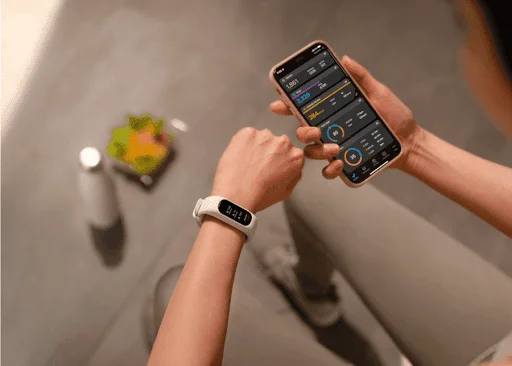In the rapidly evolving world of health tech, wearable fitness trackers are no longer just step counters—they’ve become advanced health monitoring tools. One such essential upgrade is the integration of SpO2 sensors. A Fitness band with SpO2 is now considered a must-have for anyone serious about understanding their body’s oxygen levels and overall wellness.
Whether you’re a fitness enthusiast, a working professional, or someone who wants to stay on top of their health metrics, the right fitness band can empower you with insights that were once only available in clinical settings. Let’s explore how these devices work, their benefits, and what makes them indispensable in today’s health-conscious world.
What Is SpO2 and Why Is It Important?
SpO2 stands for peripheral capillary oxygen saturation. It’s a measure of how much oxygen your red blood cells are carrying and how well oxygen is being delivered to the body’s extremities. Normally, a healthy SpO2 reading ranges from 95% to 100%.
Monitoring your SpO2 levels regularly can help detect early signs of respiratory issues, such as sleep apnea, chronic obstructive pulmonary disease (COPD), or even COVID-19-related symptoms. This is why devices like a fitness band with SpO2 capability are gaining widespread attention—not only for athletes but also for general health monitoring.
The Evolution of Fitness Bands
From Steps to Vital Signs
Initially, fitness bands were designed to count steps, estimate calories burned, and track general activity levels. Over time, they have evolved to include features like heart rate monitoring, sleep tracking, GPS, and now, SpO2 sensors. This evolution makes them far more than simple workout companions—they’re personal health assistants on your wrist.
Compact Yet Powerful
Today’s fitness bands are sleek, lightweight, and filled with powerful sensors that can give near-instantaneous data about your health. The inclusion of SpO2 functionality is a game-changer, offering real-time oxygen saturation levels and helping you take action before small health issues escalate into serious ones.
Key Benefits of a Fitness Band with SpO2
1. Early Detection of Health Issues
SpO2 monitoring provides a window into your respiratory health. Low oxygen levels may indicate potential health issues like asthma, pneumonia, or cardiovascular conditions. With this feature on your wrist 24/7, early warnings can prompt quicker action.
2. Sleep Monitoring
One of the most useful applications of SpO2 tracking is during sleep. It can help identify issues like sleep apnea by tracking oxygen drops through the night. This data can be used to improve sleep hygiene or even be shared with healthcare providers for better diagnosis.
3. Altitude Adaptation
For hikers, mountaineers, or travelers visiting high-altitude locations, SpO2 tracking can help ensure that your body is adjusting well to the thinner air. A sudden drop in oxygen levels can be a sign of altitude sickness, and your fitness band can alert you before symptoms become severe.
4. Workout Optimization
Fitness bands with SpO2 allow athletes and gym-goers to optimize training by monitoring how well their bodies utilize oxygen during intense exercise. It’s a valuable metric to gauge endurance and recovery times.
How SpO2 Sensors Work in Fitness Bands
SpO2 sensors in fitness bands use a method called pulse oximetry. Here’s a simplified explanation:
- Light-based technology: The band emits red and infrared light through the skin.
- Absorption measurement: The amount of light absorbed by oxygenated and deoxygenated blood is measured.
- Real-time data: This information is then translated into a percentage of blood oxygen saturation, shown on the device’s screen or connected app.
This non-invasive process is completely safe and can deliver accurate readings within seconds.
Choosing the Right Fitness Band with SpO2
When shopping for a fitness band with this feature, consider the following factors:
1. Sensor Accuracy
Look for devices that use high-grade sensors capable of delivering clinical-level accuracy.
2. Battery Life
Continuous SpO2 monitoring can drain the battery. Choose a band with a long battery life (5-10 days or more) to ensure you can wear it without constant recharging.
3. App Integration
Make sure the fitness band syncs seamlessly with a reliable mobile app that stores your historical data and provides personalized insights.
4. Design and Comfort
Since you’ll be wearing it most of the time, comfort is key. Choose a lightweight design with a skin-friendly strap.
5. Brand Reputation
Opt for a trusted brand that stands behind its product with good customer support and regular firmware updates.
Bleo Band: A Perfect Example
The Fitness band with SpO2 from Bleo exemplifies everything a modern health tracker should offer. It combines real-time SpO2 monitoring with heart rate tracking, sleep analysis, and activity tracking in a stylish, compact form factor. With a user-friendly interface and intelligent alerts, Bleo makes health monitoring accessible to everyone—whether you’re an athlete or just someone looking to take better care of yourself.
Future of Wearables: From Fitness Bands to Health Rings
While fitness bands are leading the current wearable trend, the next big thing in personal health tech is emerging in the form of health rings. These rings are even more discreet and offer a similar (and sometimes more comprehensive) array of sensors packed into a minimalist design.
Health rings are particularly suited for 24/7 monitoring without the bulk of a band. They offer continuous heart rate, SpO2, temperature, and even stress level tracking—all without requiring users to alter their style or daily routine. As technology shrinks and battery life improves, we can expect these rings to rival and even surpass fitness bands in functionality.
Conclusion
As we navigate a world increasingly focused on preventative healthcare and personal well-being, investing in a fitness band with SpO2 is one of the smartest choices you can make. These devices not only keep you informed about your physical activity but also offer deep insights into your internal health metrics, allowing you to live a longer, healthier life.


